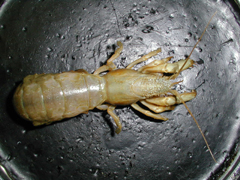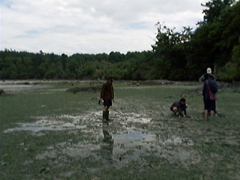Mud shrimp Area
The mud shrimp area consisted of silty mud that was sometimes
more than 50 cm deep. The area is partly covered by the green alga
Ulva. (For details on the sediment composition, see the physical
environment page.) It is a potentially dangerous area for exploring
due to foot sinkage. In addition to finding three families of polychaete
worms (Lumbrineridae, Nereidae, and Orbiniidae), one sea cucumber
species (Leptosynapta clarki) and three species of molluscs (including
the bent-nose clam, Macoma nasuta) below the surface, two thalassinid
crustaceans were also common in the sediment (mud shrimp Upogebia pugettensis
and ghost shrimp Callianassa californiensis) and were rarely
encountered elsewhere in False Bay. A small commensal clam (Orobitella
rugifera), which attaches to the underside of Upogebia (see
middle photo above), was also particular to this habitat. The species composition
in this area may have been partly determined by the muddy substrate, its
protection from wave action, and the partial algal covering.
Click here to get an overview of taxonomic
diversity of this habitat as compared to the other three.
Click here to learn about the abundance
of organisms or to get a description
of organisms found in this habitat.
Go here to learn more about protection,
reproduction, feeding,
and locomotion of these
organisms.





